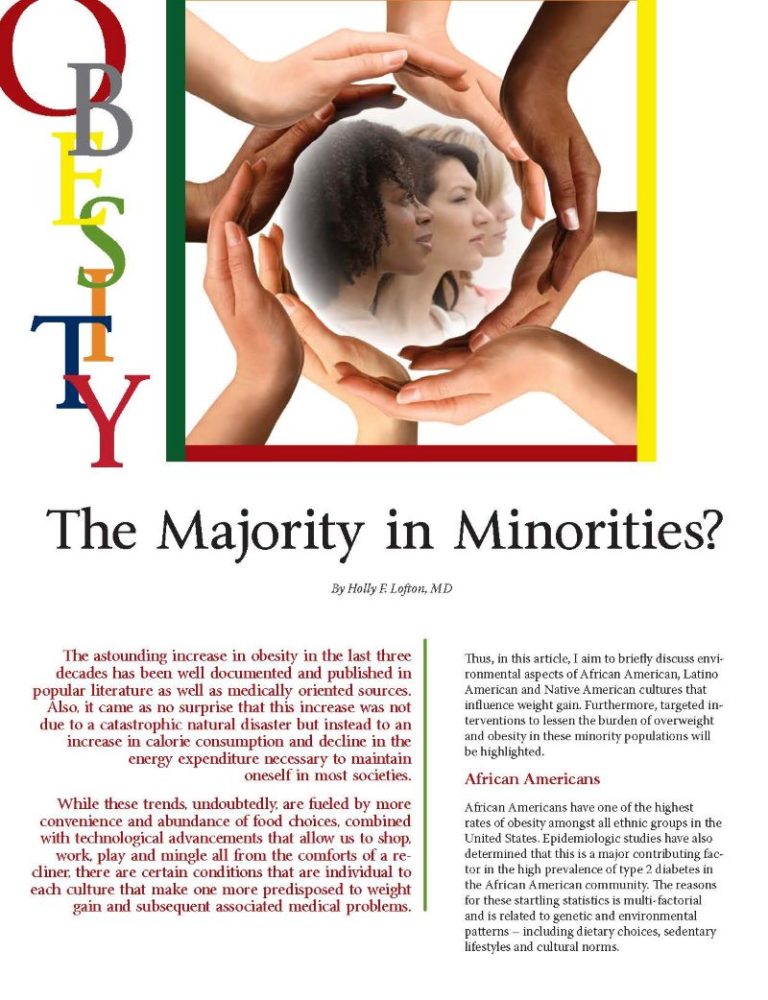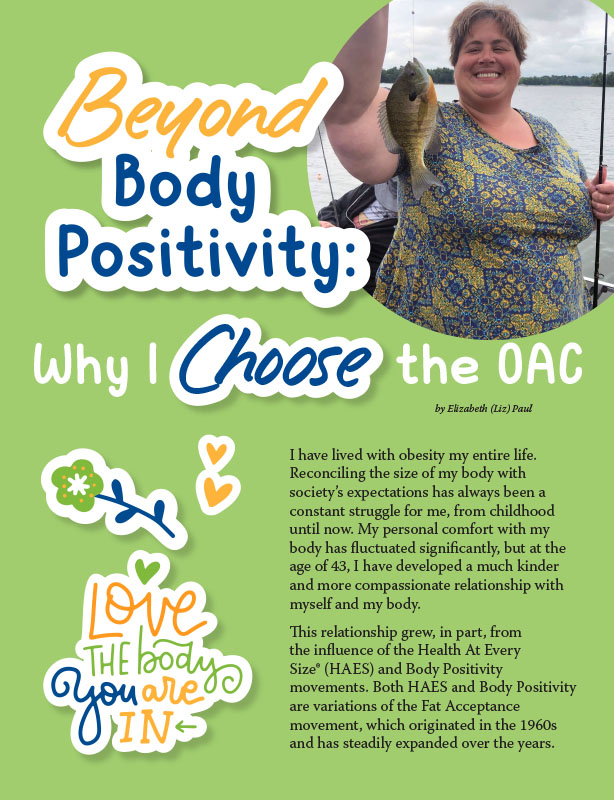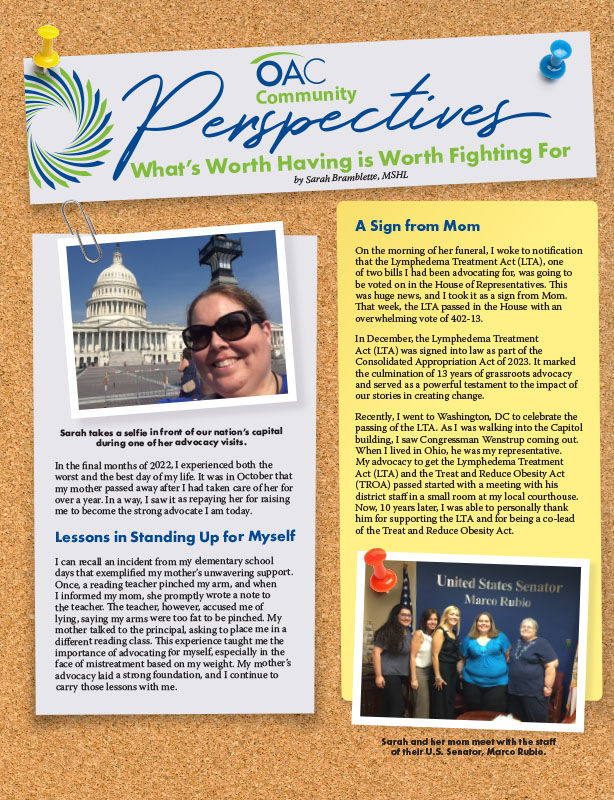Obesity – The Majority in Minorities


by Holly F. Lofton, MD
Spring 2010
The astounding increase in obesity in the last three decades has been well documented and published in popular literature as well as medically oriented sources. Also, it came as no surprise that this increase was not due to a catastrophic natural disaster but instead to an increase in calorie consumption and decline in the energy expenditure necessary to maintain oneself in most societies.
While these trends, undoubtedly, are fueled by more convenience and abundance of food choices, combined with technological advancements that allow us to shop, work, play and mingle all from the comforts of a recliner, there are certain conditions that are individual to each culture that make one more predisposed to weight gain and subsequent associated medical problems.
Thus, in this article, I aim to briefly discuss environmental aspects of African American, Latino American and Native American cultures that influence weight gain. Furthermore, targeted interventions to lessen the burden of overweight and obesity in these minority populations will be highlighted.
African Americans
African Americans have one of the highest rates of obesity amongst all ethnic groups in the United States. Epidemiologic studies have also determined that this is a major contributing factor in the high prevalence of type 2 diabetes in the African American community. The reasons for these startling statistics is multi-factorial and is related to genetic and environmental patterns – including dietary choices, sedentary lifestyles and cultural norms.
Studies have revealed that only a minority of African American men and women perform the recommended 30 minutes of moderate physical activity at least four days a week. This may be due to time constraints, exhaustion, lack of motivation/social support or lack of an ideal area in which to exercise.
In addition, the traditional “soul food” diet contains foods rich in pork fat, butter and salt – all of which can cause excessive weight gain and fat consumption.
In response to these alarming statistics and therefore increasing prevalence of weight-related medical conditions, effective weight management interventions targeting African Americans have been successful in achieving awareness of and in preventing and treating obesity in the community. Most notably, partnerships with churches, barber shops, newspapers and radio stations have been effective avenues to spread the word about maintaining a healthy lifestyle and the importance of seeing a physician regularly.
Native Americans and Alaskan Americans
American Indians and Alaskan natives (referred to in literature as AI/AN) make up about 2.5 million of the United States population. While most reside in urban areas, up to 33 percent live on reservations or historic trust lands. American Indians are most populous in Alaska, Arizona, California, Michigan, New Mexico, New York, North Carolina, Texas and Washington State. While there are limited studies performed on AI/AN, it has been confirmed that obesity is widespread.
This population also has a genetic predisposition to type 2 diabetes that is well documented in medical literature. The synergistic effects of this inborn likelihood of diabetes and assimilation of American dietary patterns with those of AI/AN have created higher rates of obesity and diabetes.
While the traditional AI/AN lifestyle was rich in farming, hunting and fishing, modern conveniences allow one to forego these activities and easily acquire a diet high in refined carbohydrates, fat and sodium. A Pima Indian living 100 years ago would need to expend several hundred calories daily to farm or hunt, and thus could maintain a normal weight even with eating the typical carbohydrate-rich Pima diet.
Today, the use of wild produce has decreased and common staples in the AI/AN diet include fry bread, home-fried potatoes, high fat pork products and soft drinks. Additionally, the sudden impact of fast food restaurants near reservations and the convenience of deep frying instead of using direct heat to prepare foods has lead to an overall calorie excess.
The development of reservations for AI/AN has also impacted the energy expenditure of the society. Traditional ceremonies, which involved dancing, especially when food was plentiful, may not be performed as frequently. Decreases in occupational physical activity and lack of recreational facilities on reservations further exacerbate this problem.
In response to these alarming trends, AI/AN groups have begun a resurgence of belief systems that emphasize purity, healthfulness and harmony in foods. Also, returning to the traditional diet of nutrient-rich foods low in fat and sugar will have a positive impact on obesity. Finally, school-based programs that encourage healthy eating and physical activity have emerged on reservations.
Hispanic/Latino Americans
In the Hispanic/Latino community, Mexican Americans comprise 58 percent of the population. This article will focus on Mexican Americans as a group, but several other Hispanic/Latino nations are represented in the United States.
The next largest groups include (in descending order): Puerto Ricans, Cuban Americans and Dominican Americans. Hispanic/Latino Americans have a disproportionate amount of overweight/obesity and diabetes and diabetic – related conditions in comparison to non-Hispanic Americans.
This disparity is partially due to a diet rich in complex carbohydrates such as corn, beans, rice and bread. With assimilation to American culture, the shift has occurred from traditional cooking methods to frying or other oil-based methods as a predominant form of meal preparation. This, along with large portion sizes, has lead to an overall increase in saturated fat and calorie consumption. Also, sugary drinks have replaced more traditional fruit-based (and thus nutrient-rich) drinks. Overall, this diet has compounded to create a high-fat, vitamin- deficient diet that can be detrimental to development in children and precipitate a range of disorders of glucose metabolism and cardiovascular disease in adults.
Furthermore, limited access to culturally appropriate healthcare is another barrier to be overcome in the fight against obesity in the Hispanic/Latino community. Healthcare providers must be sure to provide adequate resources to communicate with patients about dietary intake and physical activity. As we reach out and become a part of these communities we must also take heed of the importance of culture and make appropriate recommendations with regard to diet. One cannot expect everyone to feel comfortable eating a typical “1500 calorie American diet.” Instead, modifications can be made to the Hispanic/Latino diet that can lower fat and calorie content. Visit www.cheflala.com for recipe ideas.
Conclusion
Healthier ethnic food recipes can also be found on www.nutrition.gov and in a variety of ethnic cookbooks. As usual, one should always discuss specific nutritional requirements with a healthcare provider. Regardless of ethnic background, realizing that your weight matters to your health is extremely important.
Most Americans do not even know they are impacted by excess weight until they are diagnosed with a life-threatening illness, such as diabetes, hypertension and much more. In an effort to combat this and educate the public, the Obesity Action Coalition has developed a national health and weight awareness initiative, the Your Weight Matters Campaign. To view the campaign site, visit www.yourweightmatters.org.
About the Author:
Holly F. Lofton, MD, is currently an Associate Physician at the Geisinger Center for Nutrition and Weight Management in Danville, PA. Her specialty is geared toward adapting life-long lifestyle changes that lead to successful weight-loss as well as caring for patients undergoing bariatric surgery. Dr. Lofton is a member of the OAC Advisory Board.
References:
American Public Health Association Issue Brief Volume 1 Number 2 Zainab Khan Scientific and Professional Affairs, Summer 2003. The Obesity Epidemic in U.S. Minority Communities
J Esparza1,a, C Fox2,a, I T Harper2, P H Bennett2, L O Schulz3, M E Valencia1 and E Ravussin1 Daily energy expenditure in Mexican and USA Pima Indians: low physical activity as a possible cause of obesity International Journal of Obesity January 2000, Volume 24, Number 1, Pages 55-59
by Robyn Pashby, PhD Summer 2023 To do something a little different, I’d like to begin this…
Read Articleby Elizabeth (Liz) Paul Summer 2023 I have lived with obesity my entire life. Reconciling the size of…
Read Articleby Sarah Bramblette, MSHL Summer 2023 In the final months of 2022, I experienced both the worst…
Read Article









